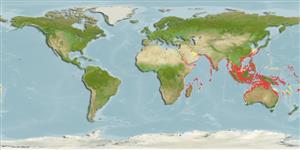>
Eupercaria/misc (Various families in series Eupercaria) >
Lutjanidae (Snappers) > Lutjaninae
Etymology: Lutjanus: Malay, ikan lutjan, name of a fish.
Eponymy: Dr Patrick Russell (1727–1805) was a British surgeon and naturalist. [...] (Ref. 128868), visit book page.
More on author: Bleeker.
Environment: milieu / Zona climática / intervalo de profundidade / distribution range
Ecologia
marinhas; estuarina associadas(os) a recifes; intervalo de profundidade 3 - 80 m (Ref. 9710), usually 20 - 50 m (Ref. 48635). Tropical; 31°N - 38°S, 31°E - 178°W (Ref. 55)
Western Pacific: Indian Ocean distribution provisionally included as records of L. indicus; species needs to be reassessed, preferably utilising genetic analysis.
Comprimento de primeira maturação / Tamanho / Peso / Idade
Maturidade: Lm ?, range 29 - ? cm
Max length : 50.0 cm TL macho/indeterminado; (Ref. 469); common length : 30.0 cm TL macho/indeterminado; (Ref. 55)
Espinhos dorsais (total) : 10; Raios dorsais (total) : 14; Espinhos anais: 3; Raios anais : 8. This species is distinguished by the following characters: body moderately deep to somewhat slender, greatest body depth 2.6-2.8 in SL; preopercular notch and knob poorly developed; vomerine tooth patch triangular or diamond-shaped, with a medial posterior extension; tongue with a patch of granular teeth; gill rakers of first gill arch 6-7 + 7-11 = 13-18 (including rudiments); caudal fin truncate or slightly emarginate; scale rows on back rising obliquely above lateral line. Colour generally pink to whitish with a silvery sheen; a black spot, mainly above lateral line, below anterior rays of soft dorsal fin (adults from the Indian Ocean usually with 7-8 narrow golden brown stripes on sides); juveniles whitish with black stripes on sides and most Indo-Pacific fish with a pale-edged round black spot on upper back (Ref 9821, 90102).
Body shape (shape guide): fusiform / normal; Cross section: oval.
Adults inhabit offshore coral reefs and also inshore rocky and coral reefs (Ref. 30573), at moderate depths, usually over 20 m, and is more common in about 50 m depth (Ref. 48635). Juveniles frequent mangrove estuaries and lower reaches of freshwater streams (Ref. 30573, 48635). They feed on benthic invertebrates and fish (Ref. 5213). Sold in Hong Kong live fish markets (Ref. 27253). A common market fish throughout its range; also a component of artisanal fisheries. Caught with handlines, traps, and bottom trawls and marketed mostly fresh (Ref. 9821).
Ciclo de vida ou comportamento de acasalamento
Maturidade | Reprodução | Desova | Ovos | Fecundidade | Larvas
Allen, G.R., 1985. FAO Species Catalogue. Vol. 6. Snappers of the world. An annotated and illustrated catalogue of lutjanid species known to date. FAO Fish. Synop. 125(6):208 p. Rome: FAO. (Ref. 55)
Status na Lista Vermelha da UICN (Ref. 130435: Version 2025-1)
Ameaça para os humanos
Harmless
Uso pelos humanos
Pescarias: espécies comerciais; Aquacultura: espécies comerciais; peixe esportivo: sim
Ferramentas
Relatórios especiais
Baixar XML
Fontes da internet
Estimates based on models
Preferred temperature (Ref.
123201): 24.4 - 29.1, mean 28 °C (based on 1448 cells).
Índice de diversidade filogenética (Ref.
82804): PD
50 = 0.5000 [Uniqueness, from 0.5 = low to 2.0 = high].
Bayesian length-weight: a=0.01318 (0.00848 - 0.02050), b=2.98 (2.86 - 3.10), in cm total length, based on LWR estimates for this species & Genus-body shape (Ref.
93245).
Nível Trófico (Ref.
69278): 4.1 ±0.4 se; based on diet studies.
Resiliência (Ref.
120179): médio(a), tempo mínimo de duplicação da população 1,4 - 4,4 anos (Assuming tm<5).
Fishing Vulnerability (Ref.
59153): Moderate vulnerability (40 of 100).
🛈
Nutrients (Ref.
124155): Calcium = 32.3 [20.1, 49.8] mg/100g; Iron = 0.348 [0.224, 0.578] mg/100g; Protein = 18.7 [17.2, 19.9] %; Omega3 = 0.146 [0.100, 0.217] g/100g; Selenium = 57.8 [34.0, 93.4] μg/100g; VitaminA = 209 [39, 856] μg/100g; Zinc = 0.46 [0.35, 0.64] mg/100g (wet weight);
